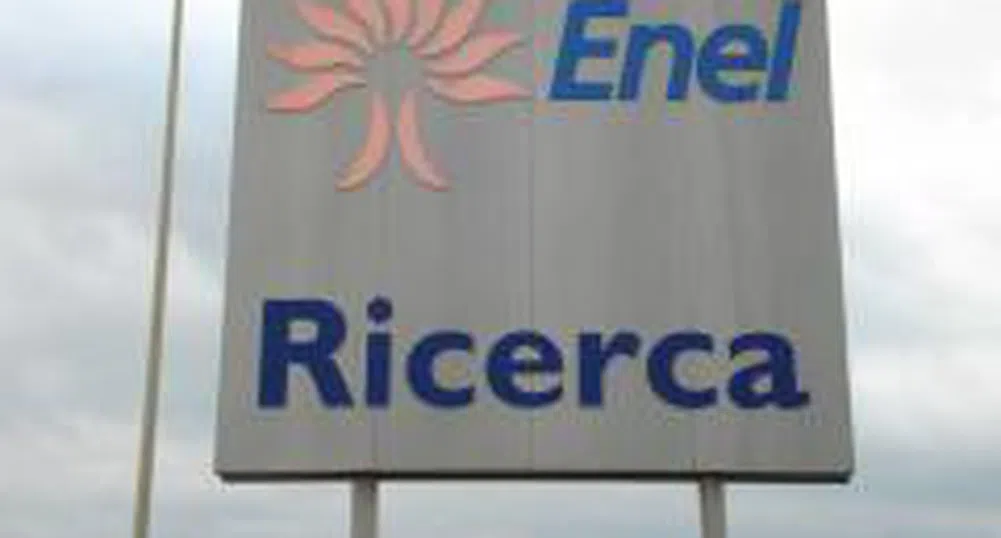Enel Bets on Renewable Energy and Innovation, Discusses New Projects with Maritza East 3

The largest utility company in Italy Enel is implementing a 7.4 billion euro plan for the development of renewable energy sources and innovative technologies in the 5 year period between 2008 and 2012.
„The biggest challenge for energy companies nowadays is the reduction of carbon dioxide emissions,” says Sauro Pasini, head of the Enel research center in Livorno, Italy.
The center in Livorno is currently working on technologies for carbon dioxide capture and sequestration. Enel scientists are developing ways in which the CO2 can be stored or injected back in the soil.
Enel has a small demo plant, with 5MWt capacity, in the south of Italy, where these technologies are tested. When the experiments are successfully completed the company will build a ten times larger plant in Brindisi, which will be able to capture 1.5 million tonnes of carbon dioxide per year. This will happen no earlier than 2014.
With this technology Enel may participate in the tender for the new capacity in the Maritza East 3 Complex in Bulgaria.
Enel in Bulgaria
Enel and Maritza East 3 are currently discussing projects for energy production using biomass and photovoltaic power in Bulgaria, Sauro Pasini also said.
The company is studying the possibilities for producing wind energy on two sites in Bulgaria – in the municipalities of Gurkovo and Sevlievo. The projects are currently at a preliminary research stage – experts are measuring the wind power and the terrains' suitability.
Enel is planning to carry out such tests on several other locations in Bulgaria, which have not yet been selected.
Another possibility the company is exploring is that of energy generation from biomass. The preliminary research stage here has to be completed by mid-2009. Then, if the project is rendered economically viable, the company will seek environmental approvals.
Other Projects
Enel provides 25% of the electricity on Toscana via geothermal energy.
2% of the electricity in Italy is produced using this method.
What is geothermal energy?
Scientists estimate that the heat contained in the first five kilometers of the Earth’s surface is equivalent to about 500,000 times current world energy demand.
Today, geothermal energy produces about 10,000 MW worldwide.
Currently, Enel’s 31 geothermal plants in Italy produce about 10% of world geothermal output.
Enel is also investing in geothermal projects in Latin America, including projects in Chile, Nicaragua, Guatemala and El Salvador. Enel plans to increase its geothermal capacity in the countries where it is present from 678 MW in 2008 to 837 MW in 2012.
Last year, Enel bought AMP Resources in the US, adding 150 MW of planned geothermal capacity in California, Nevada and Utah.
The geothermal power plant in Lardarello – the largest of its kind in Europe
Today, Enel provides about 25% of Tuscany’s power using geothermal energy – more than 5.2 TWh of electricity to about 2.5 million households. In doing so, Enel saves the equivalent of 3.6 million tonnes of CO2 emissions thanks to geothermal energy.
Enel operates 31 geothermal power plants in Larderello with a capacity of 671 MW. Enel plans to commission five new geothermal units by 2012.
The Diamond
“Il Diamante” (“The Diamond”) is a new generation solar power plant designed and developed by Enel’s Research department and the University of Pisa.
Mounted on the faces of a geodesic dome structure popularized by R. Buckminster Fuller, the solar panels generate electricity that can be stored in the form of hydrogen for use when the skies are overcast.
The whole structure is brought together by a construction of huge proportions made of prefabricated glass and steel, creating a new type of functional power plant whose striking appearance achieves an harmonious balance between architecture, technology and nature.
For the first Diamante installations, two important locations are being considered, both in Tuscany: in San Rossore Park, and at the Villa Medicea in Pratolino.
The Diamond is composed of a sphere, 8 metres in diameter. Thirty-eight polycrystalline silicon
solar panels are arranged on the crown and the south-facing side. The remaining surface is covered with glass panels to protect the structure against the wind.
Inside, in three spheres, each 2 metresin diameter, there are hydrogen storage tanks, using the advanced technology of metal hydrides.
The plant can generate enough electricity to meet the energy demands of a small apartment block.
A model of the Diamond in front of Enel's research center in Livorno, Italy
Achieving zero emission plants by 2020 is not a dream, but a realistic objective, Enel says.
Financial Result
Despite the world financial turmoil, Enel will meet profit targets, Luigi Ferraris, head of administration and planning said on Bloomberg TV.
Enel's full-year earnings before interest, tax, depreciation and amortization will beat analysts' expectations and be ``well above'' the 13.3 billion-euro ($18 billion) consensus, Chief Executive Officer Fulvio Conti said Aug. 1. Ebitda next year will beat the utility's forecast of 13.8 billion euros, he said.
Conti pledged in March to maintain a 49-cent annual dividend and in August said that was ``enough'' for investors.
Photos: Profit.bg
)

&format=webp)
&format=webp)
&format=webp)
&format=webp)
&format=webp)
&format=webp)
&format=webp)